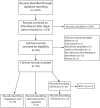Challenges in Maintaining the Hemostatic Balance in Children Undergoing Extracorporeal Membrane Oxygenation: A Systematic Literature Review
- PMID: 33392120
- PMCID: PMC7772234
- DOI: 10.3389/fped.2020.612467
Challenges in Maintaining the Hemostatic Balance in Children Undergoing Extracorporeal Membrane Oxygenation: A Systematic Literature Review
Abstract
Background: Despite advances in technology and clinical experience, the incidence of hemostatic complications, including bleeding and thrombosis, remains high in children supported with extracorporeal membrane oxygenation (ECMO). These hemostatic complications are important to prevent, since they are associated with increased morbidity and mortality. This systematic literature review aims to outline the most important risk factors for hemostatic complications in children undergoing ECMO treatment, to summarize the reported alternative anticoagulant drugs used in pediatric ECMO and to describe studied associations between coagulation tests and hemostatic complications. Methods: A literature search was performed in Embase, Medline, Web of Science Core Collection, Cochrane Central Register of Controlled Trials, and Google Scholar in February 2020. Included studies were studies evaluating children (<18 years old) treated with ECMO, and studies evaluating risk factors for hemostatic complications, alternative anticoagulants, or the association between coagulation tests and hemostatic complications. Results: Out of 1,152 articles, 35 studies were included. Thirteen out of 49 risk factors were investigated in three or more studies. Most consistent results were found regarding ECMO duration and pH. However, evidence for risk factors was equivocal in the majority of studies, which is explained by the variability of populations studied, definitions of hemostatic complications, ECMO circuits, anticoagulation protocols, transfusion triggers and monitoring of anticoagulation. Five studies described alternative anticoagulants, including bivalirudin (n = 3), argatroban (n = 1) and FUT (n = 1). Higher anti-factor Xa levels were associated with less clotting events in one of nine studies, investigating the association between tests and hemostatic complications. Two studies revealed an association between anti-factor Xa assay-based protocols and a decreased number of transfusions, bleedings and need for circuit change. Conclusion: Studies regarding risk factors showed conflicting results and a few retrospective studies reported the use of new anticoagulants and data on coagulation tests in relation to hemostatic complications. To decrease hemostatic complications in ECMO children, prospective multicenter studies are needed with clear bleeding and thrombotic definitions, and the best possible standardization of ECMO circuits used, anticoagulation protocols, and transfusion triggers.
Keywords: bivalirudin; bleeding; extra corporeal membrane oxygenation (ECMO); pediatrics; risk factor; thrombosis; unfractionated heparin (UFH).
Copyright © 2020 Drop, Wildschut, Gunput, de Hoog and van Ommen.
Conflict of interest statement
The authors declare that the research was conducted in the absence of any commercial or financial relationships that could be construed as a potential conflict of interest.
Figures
Similar articles
-
Evaluation of an aPTT guided versus a multimodal heparin monitoring approach in patients on extra corporeal membrane oxygenation: A retrospective cohort study.Perfusion. 2025 Apr;40(3):557-567. doi: 10.1177/02676591241253474. Epub 2024 May 13. Perfusion. 2025. PMID: 38739366 Free PMC article. Review.
-
Argatroban Anticoagulation for Adult Extracorporeal Membrane Oxygenation: A Systematic Review.J Intensive Care Med. 2022 Apr;37(4):459-471. doi: 10.1177/0885066621993739. Epub 2021 Mar 3. J Intensive Care Med. 2022. PMID: 33653194
-
Is bivalirudin an alternative anticoagulant for extracorporeal membrane oxygenation (ECMO) patients? A systematic review and meta-analysis.Thromb Res. 2022 Feb;210:53-62. doi: 10.1016/j.thromres.2021.12.024. Epub 2021 Dec 31. Thromb Res. 2022. PMID: 35007937
-
Use of rotational thromboelastometry to predict hemostatic complications in pediatric patients undergoing extracorporeal membrane oxygenation: A retrospective cohort study.Res Pract Thromb Haemost. 2021 Jul 14;5(5):e12553. doi: 10.1002/rth2.12553. eCollection 2021 Jul. Res Pract Thromb Haemost. 2021. PMID: 34278189 Free PMC article.
-
Anticoagulation and hemostasis on extracorporeal membrane oxygenation.Curr Opin Pediatr. 2023 Jun 1;35(3):297-302. doi: 10.1097/MOP.0000000000001247. Epub 2023 Mar 28. Curr Opin Pediatr. 2023. PMID: 36974451 Review.
Cited by
-
Extracorporeal membrane oxygenation in children receiving haematopoietic cell transplantation and immune effector cell therapy: an international and multidisciplinary consensus statement.Lancet Child Adolesc Health. 2022 Feb;6(2):116-128. doi: 10.1016/S2352-4642(21)00336-9. Epub 2021 Dec 9. Lancet Child Adolesc Health. 2022. PMID: 34895512 Free PMC article. Review.
-
Heparin-based versus bivalirudin-based anticoagulation in pediatric extracorporeal membrane oxygenation: A systematic review.Front Med (Lausanne). 2023 Mar 14;10:1137134. doi: 10.3389/fmed.2023.1137134. eCollection 2023. Front Med (Lausanne). 2023. PMID: 36999064 Free PMC article.
-
Novel Coagulation Test Detects Anticoagulation Resistance and Is Associated With Thrombotic Events in Pediatric Patients Requiring Extracorporeal Membrane Oxygenation.Crit Care Explor. 2022 Oct 25;4(10):e0776. doi: 10.1097/CCE.0000000000000776. eCollection 2022 Oct. Crit Care Explor. 2022. PMID: 36311559 Free PMC article.
-
Coagulation in pediatric extracorporeal membrane oxygenation: A systematic review of studies shows lack of standardized reporting.Res Pract Thromb Haemost. 2022 Mar 28;6(2):e12687. doi: 10.1002/rth2.12687. eCollection 2022 Feb. Res Pract Thromb Haemost. 2022. PMID: 35382349 Free PMC article. Review.
-
The Changing Landscape of Anticoagulation in Pediatric Extracorporeal Membrane Oxygenation: Use of the Direct Thrombin Inhibitors.Front Med (Lausanne). 2022 Jul 6;9:887199. doi: 10.3389/fmed.2022.887199. eCollection 2022. Front Med (Lausanne). 2022. PMID: 35872781 Free PMC article. Review.
References
-
- Bartlett RH, Gazzaniga AB, Jefferies MR, Huxtable RF, Haiduc NJ, Fong SW. Extracorporeal membrane oxygenation (ECMO) cardiopulmonary support in infancy. Trans Am Soc Artif Intern Organs. (1976) 22:80–93. - PubMed
-
- ECLS registry report , International Summary. Ann Arbor: Extracorporeal Life Support Organization (2020). p. 1 Available online at: https://www.elso.org/Portals/0/Files/Reports/2020_January/International%... (accessed May 04, 2020).
-
- ECLS registry report , International Summary. Ann Arbor: Extracorporeal Life Support Organization (2017). p.1–34. Available online at: https://www.elso.org/Portals/0/Files/Reports/2017/International%20Summar... (accessed May 04, 2020).
Publication types
LinkOut - more resources
Full Text Sources


